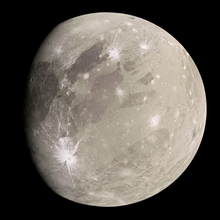Ganymede (oē-chheⁿ)
Ganymede sī Bo̍k-chheⁿ 63-ê khak-tēng ê oē-chheⁿ chi it.
 Ganymede photographed by Juno in 2021 | |||||||||||||
| Hoat-kiàn[1][2] | |||||||||||||
|---|---|---|---|---|---|---|---|---|---|---|---|---|---|
| Hoat-kiàn-chiá | Galileo Galilei | ||||||||||||
| Hoat-kiàn ji̍t-chí | January 7, 1610 | ||||||||||||
| Miâ-hō | |||||||||||||
| Ho͘-im |
/ˈɡænəˌmiːd/[3] GAN-ə-MEED | ||||||||||||
Hō-miâ iû-lâi | Γανυμήδης, Ganymēdēs | ||||||||||||
| Jupiter Pang-bô͘:Rn | |||||||||||||
| Adjectives |
Ganymedian,[4] Ganymedean[5][6] (/ˌɡænəˈmiːdi.ən/) | ||||||||||||
| Kúi-tō sèng-chit | |||||||||||||
| Kīn-tiám | 1069200 km[lower-alpha 1] | ||||||||||||
| Hn̄g-tiám | 1071600 km[lower-alpha 2] | ||||||||||||
| 1070400 km[7] | |||||||||||||
| Lî-sim-lu̍t | 0.0013[7] | ||||||||||||
| 7.15455296 d[7] | |||||||||||||
Pêng-kin kúi-tō sok-le̍k | 10.880 km/s | ||||||||||||
| Khi-pêng |
2.214° (to the ecliptic) 0.20° (to Jupiter's equator)[7] | ||||||||||||
| Tò lia̍p chheⁿ ê ōe-cheⁿ | Jupiter | ||||||||||||
| Bu̍t-lí sèn-chit | |||||||||||||
Pêng-kin poàn-kéng | 2634.1±0.3 km (0.413 Earths)[8] | ||||||||||||
| 8.72×107 km2 (0.171 Earths)[lower-alpha 3] | |||||||||||||
| Thé-chek | 7.66×1010 km3 (0.0704 Earths)[lower-alpha 4] | ||||||||||||
| Chit-liōng | 1.4819×1023 kg (0.025 Earths)[8] (2.02 Moon's) (0.23 Mars') | ||||||||||||
Pêng-kin bi̍t-tō͘ | 1.936 g/cm3 (0.351 Earths)[8] | ||||||||||||
| 1.428 m/s2 (0.146 g)[lower-alpha 5] | |||||||||||||
| 0.3115±0.0028[9] | |||||||||||||
| 2.741 km/s[lower-alpha 6] | |||||||||||||
| synchronous | |||||||||||||
| 0–0.33°[10] | |||||||||||||
| Hoán-siā-lu̍t | 0.43±0.02[11] | ||||||||||||
| |||||||||||||
|
4.61 (opposition)[11] 4.38 (in 1951)[12] | |||||||||||||
| 1.2 to 1.8 arcseconds | |||||||||||||
| Tāi-khì-khoan | |||||||||||||
Piáu-bīn ap-le̍k | 0.2–1.2 µPa (1.97×10−12–1.18×10−11 atm)[15] | ||||||||||||
| Thé-chek cho͘-sêng | mostly oxygen[15] | ||||||||||||
|
| |||||||||||||
Tsù-kiok
siu-kái- ↑ Periapsis is derived from the semimajor axis (a) and eccentricity (e): .
- ↑ Apoapsis is derived from the semimajor axis (a) and eccentricity (e): .
- ↑ Surface area derived from the radius (r): .
- ↑ Volume derived from the radius (r): .
- ↑ Surface gravity derived from the mass (m), the gravitational constant (G) and the radius (r): .
- ↑ Escape velocity derived from the mass (m), the gravitational constant (G) and the radius (r): .
Tsù-kái
siu-kái- ↑ Galilei, Galileo; translated by Edward Carlos (March 1610). Barker, Peter, pian. "Sidereus Nuncius" (PDF). University of Oklahoma History of Science. goân-loē-iông (PDF) tī December 20, 2005 hőng khó͘-pih. January 13, 2010 khòaⁿ--ê.
- ↑ "In Depth | Ganymede". NASA Solar System Exploration. June 16, 2021 khòaⁿ--ê.
- ↑ "Ganymede". Oxford English Dictionary (Online pán.). Oxford University Press. (Subscription or participating institution membership required.)
"Ganymede". Merriam-Webster Dictionary. - ↑ Quinn Passey & E. M. Shoemaker (1982) "Craters on Ganymede and Callisto", in David Morrison, ed., Satellites of Jupiter, vol. 3, International Astronomical Union, pp. 385–386, 411.
- ↑ Journal of Geophysical Research, v. 95 (1990).
- ↑ E. M. Shoemaker et al. (1982) "Geology of Ganymede", in David Morrison, ed., Satellites of Jupiter, vol. 3, International Astronomical Union, pp. 464, 482, 496.
- ↑ 7.0 7.1 7.2 7.3 "Planetary Satellite Mean Orbital Parameters". Jet Propulsion Laboratory, California Institute of Technology.
- ↑ 8.0 8.1 8.2 Showman, Adam P.; Malhotra, Renu (October 1, 1999). "The Galilean Satellites" (PDF). Science. 286 (5437): 77–84. doi:10.1126/science.286.5437.77. PMID 10506564. goân-loē-iông (PDF) tī 2011-05-14 hőng khó͘-pih. 2023-01-10 khòaⁿ--ê.
- ↑ Schubert, G.; Anderson, J. D.; Spohn, T.; McKinnon, W. B. (2004). "Interior composition, structure and dynamics of the Galilean satellites". Chū Bagenal, F.; Dowling, T. E.; McKinnon, W. B. Jupiter: the planet, satellites, and magnetosphere. New York: Cambridge University Press. pp. 281–306. ISBN 978-0521035453. OCLC 54081598.
- ↑ Bills, Bruce G. (2005). "Free and forced obliquities of the Galilean satellites of Jupiter". Icarus. 175 (1): 233–247. Bibcode:2005Icar..175..233B. doi:10.1016/j.icarus.2004.10.028.
- ↑ 11.0 11.1 Yeomans, Donald K. (July 13, 2006). "Planetary Satellite Physical Parameters". JPL Solar System Dynamics. November 5, 2007 khòaⁿ--ê.
- ↑ Yeomans; Chamberlin. "Horizon Online Ephemeris System for Ganymede (Major Body 503)". California Institute of Technology, Jet Propulsion Laboratory. April 14, 2010 khòaⁿ--ê. (4.38 on 1951-Oct-03).
- ↑ 13.0 13.1 Delitsky, Mona L.; Lane, Arthur L. (1998). "Ice chemistry of Galilean satellites" (PDF). J. Geophys. Res. 103 (E13): 31,391–31,403. Bibcode:1998JGR...10331391D. doi:10.1029/1998JE900020. goân-loē-iông (PDF) tī October 3, 2006 hőng khó͘-pih.
- ↑ Orton, G. S.; Spencer, G. R.; et al. (1996). "Galileo Photopolarimeter-radiometer observations of Jupiter and the Galilean Satellites". Science. 274 (5286): 389–391. Bibcode:1996Sci...274..389O. doi:10.1126/science.274.5286.389.
- ↑ 15.0 15.1 Hall, D. T.; Feldman, P. D.; et al. (1998). "The Far-Ultraviolet Oxygen Airglow of Europa and Ganymede". The Astrophysical Journal. 499 (1): 475–481. Bibcode:1998ApJ...499..475H. doi:10.1086/305604.
Ên-sin ua̍t-to̍k
siu-kái- Dougherty; Grasset (2011). Jupiter Icy Moon Explorer (PDF).
- "Jupiter's Great Red Spot and Ganymede's shadow". www.spacetelescope.org. ESA/Hubble. goân-loē-iông tī 2019-08-24 hőng khó͘-pih. October 31, 2014 khòaⁿ--ê.
Tsham-ua̍t
siu-kái- Oxford English Dictionary
- Oxford University Press
- Merriam-Webster Dictionary
Guā-pōo liân-kiat
siu-kái- Ganymede page at NASA's Solar System Exploration site
- Ganymede page at The Nine Planets
- Ganymede page at Views of the Solar System
- Ganymede Crater Database from the Lunar and Planetary Institute
- Images of Ganymede at JPL's Planetary Photojournal
- Movie of Ganymede's rotation from the National Oceanic and Atmospheric Administration
- Ganymede map from Scientific American article
- Ganymede map with feature names from Planetary Photojournal
- Ganymede nomenclature and Ganymede map with feature names from the USGS planetary nomenclature page
- Paul Schenk's 3D images and flyover videos of Ganymede and other outer solar system satellites
- Ganymede Orbiter Concept Archived 2013-12-25 at the Wayback Machine.
- Global Geologic Map of Ganymede (USGS)
- Google Ganymede 3D, interactive map of the moon
- Video (animation; 4:00): Flyby of Ganymede and Jupiter (NASA; July 15, 2021).
| Pún bûn-chiuⁿ sī chi̍t phiⁿ phí-á-kiáⁿ. Lí thang tàu khok-chhiong lâi pang-chō͘ Wikipedia. |